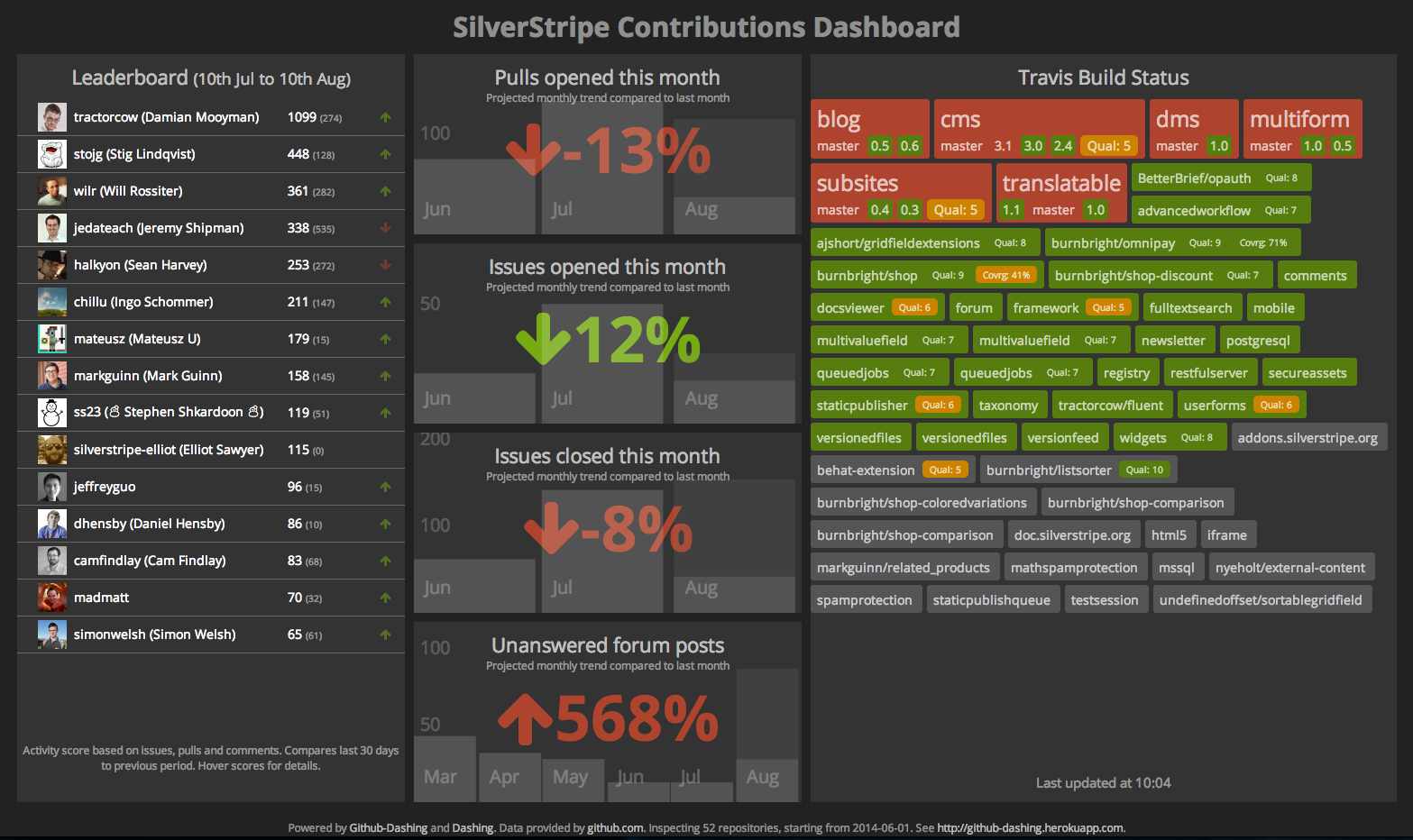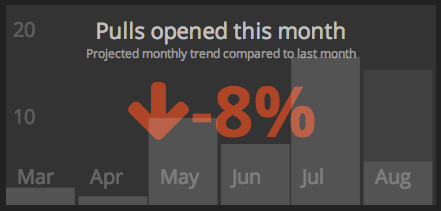Dashboard to monitor the health of github projects based on their contribution statistics.
- Aggregates usage data across multiple repos from the Github API
- Widgets support aggregate statistics of multiple repos or even all repos within an organization.
- Contributor scores based on activity in commits as well as in comments and pull requests.
- Travis CI build status across multiple branches
- Trend projections for current month on issues opened, issues closed and pull requests
- Quick integration of other data sources through a common widget framework
- Easy hosting through Heroku
All visualizations are optimized to encourage direct action by individuals, so prefers short-term trends and relative measures over long-term data. For example, the leaderboard only inspects the last 30 days of contributions, allowing new contributors to get to the top more easily.
Preview: The SilverStripe CMS project, aggregating over 50 repositories
that the project either maintains or actively contributes to.
View it live at github-dashing.herokuapp.com.

Preview: Pull request stats with trend projection for current month

Preview: Travis build status with per-branch status and code quality indicators

The dashboard is based on Dashing, a Ruby web application built on the Sinatra framework. It uses the Github API rather than githubarchive.org data dumps because of the immediate nature of dashboard update (refreshes every hour by default). The code used to be based on Google BigQuery aggregation, but this turned out to be infeasible due to query size and BigQuery pricing.
First install the required dependencies through bundle install.
The project is configured through environment variables.
Copy the .env.sample configuration file to .env.
All configuration is optional, apart from either ORGAS or REPOS.
ORGAS: Github organizations. Separate multiple by comma. Will use all repos for an organization. Example:silverstripe,silverstripe-labs.REPOS: Github repository identifiers. Separate multiple by comma. If used alongsideORGAS, the logic will add all mentioned repos to the ones retrieved fromORGAS. Example:silverstripe/silverstripe-framework,silverstripe/silverstripe-cmsSINCE: Date string, or relative time parsed through http://guides.rubyonrails.org/active_support_core_extensions.html. Example:12.months.ago.beginning_of_month,2012-01-01GITHUB_LOGIN: Github authentication is optional, but recommendedGITHUB_OAUTH_TOKEN: See aboveTRAVIS_BRANCH_BLACKLIST: A blacklist of branches ignored by repo, as a JSON string. This is useful to ignore old branches which no longer have active builds. Example:{"silverstripe-labs/silverstripe-newsletter":["0.3","0.4"]}
You can also specify a custom env file through setting a DOTENV_FILE environment variable first.
This is useful if you want to have version controlled defaults (see .env.silverstripe).
The dashboard is used by the SilverStripe CMS project, some of the functionality is specific to this use case. Simply leave out the configuration values in case you're use case is different.
FORUM_STATS_URL: Absolute URL returning JSON data for forum statistics such as "unanswered posts"
The dashboard uses the public github API, which doesn't require authentication. Depending on how many repositories you're showing, hundreds of API calls might be necessary, which can quickly exhaust the API limitations for unauthenticated use.
In order to authenticate, create a new API Access Token
on your github.com account, and add it to the .env configuration:
GITHUB_LOGIN=your_login
GITHUB_OAUTH_TOKEN=2b0ff00...................
The dashboard uses the official Github API client for Ruby (Octokit), and respects HTTP cache headers where appropriate to avoid making unnecessary API calls.
Dashing also supports custom API endpoints required for Github Enterprise, by setting
the OCTOKIT_API_ENDPOINT environment variable (http://octokit.github.io/octokit.rb/#Using_ENV_variables).
Finally, start the dashboard server:
dashing start
Now you can browse the dashboard at http://localhost:3030/default.
The Dashing jobs query for their data whenever the server is started, and then with a frequency of 1h by default.
Since Dashing is simply a Sinatra Rack app under the hood, deploying is a breeze. It takes around 30 seconds to do :)
First, sign up for the free service. Download the dev tools and install them with your account credentials.
Due to a bug in config pushing on Heroku, its important to leave all single-line values in .env unquoted.
Now you're ready to add your app to Heroku:
# Create a git repo for your project, and add your files.
git init
git add .
git commit -m "My beautiful dashboard"
# Create the application on Heroku
heroku apps:create myapp
# Push the application to Heroku
git push heroku master
# Push your `.env` configuration
heroku plugins:install git://github.com/ddollar/heroku-config.git
heroku config:push
The project has optional Sentry integration for logging exceptions.
Its particularly useful to capture Github API errors, e.g. when a project has been renamed.
To use it, configure your SENTRY_DSN in .env (docs).
You'll need to sign up to Sentry to receive a valid DSN.
Pull requests are very welcome! Please make sure that the code you're fixing is actually part of this project, and not just generated from the upstream Dashing library templates.
Thanks to SilverStripe Ltd. for sponsoring the Heroku hosting and the physical dashboard at the SilverStripe offices in Wellington, New Zealand.
Distributed under the MIT license
